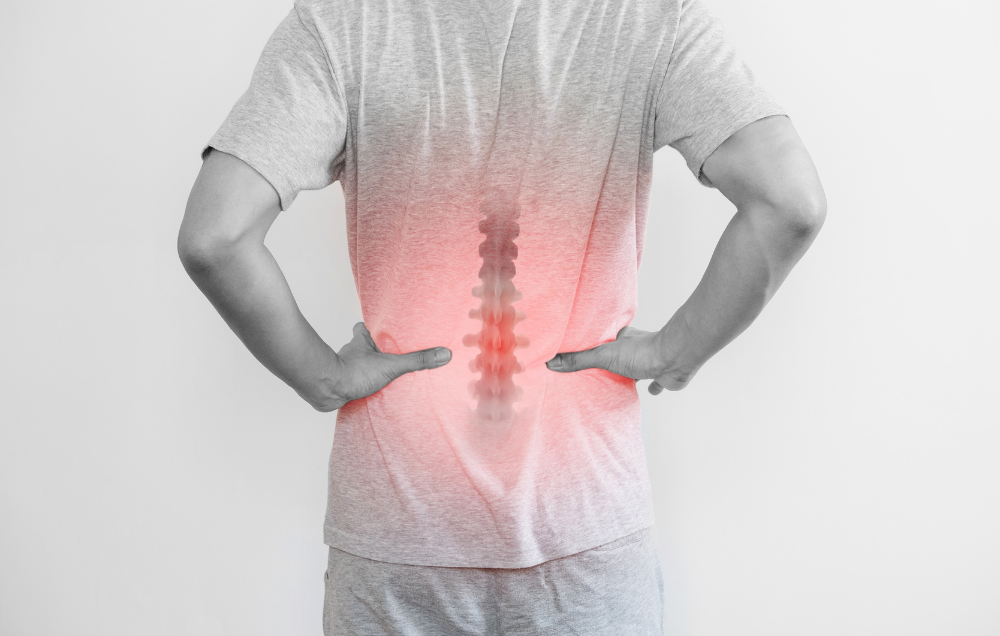Contents
The spine is made up of 33 vertebrae that are categorized into five regions: cervical (neck), thoracic (upper back), lumbar (lower back), sacral and coccygeal. Between the vertebrae are intervertebral discs. These discs provide cushion from shock during movement and allow spinal flexibility. Nerves stem from the spinal cord and travel through the space between the vertebrae. The spine helps us stand upright, bend, and move flexibly. The spine can be susceptible to a variety of conditions, including sciatica.
What is sciatica?
Sciatica refers to the pain that radiates along the path of the sciatic nerve, which is the longest and widest nerve in the human body. It starts in the lower back and extends down through the buttocks into the back of each leg. It is known as sciatica when the sciatic nerve is compressed or irritated. A herniated disc, bone spur or spinal stenosis often causes this compression or irritation. It is a common condition; an estimated 40% of people will experience sciatica at some point in their lives. It most often affects people around 40 years old. However, it can occur at any age.
Symptoms of sciatica
The symptoms of sciatica can vary from person to person and in intensity. Symptoms can include:
- Constant pain — A constant dull ache or sharp, shooting pain can characterize sciatic pain. This pain radiates from the lower back down into the leg.
- Numbness or tingling — Some people with sciatica may experience numbness, tingling, or a pins-and-needles sensation in the leg or foot.
- Muscle weakness — Muscle weakness in the leg or foot can make it difficult to move or control the affected leg.
- Difficulty sitting or standing — Sciatic pain can worsen after prolonged sitting or standing periods. This can make it challenging to find a comfortable position.
- Painful movements — Certain movements, like coughing, sneezing or bending, can make sciatic pain worse due to increased pressure on the nerve.
Treatment options for sciatica
Treatments for sciatica can involve a combination of treatment approaches, including:
- Rest or modifying activities — Avoiding activities that worsen your pain and prioritizing rest can help during the acute phase. However, extended bed rest should be avoided. It can weaken muscles and make your recovery longer.
- Pain medication — Over-the-counter pain relievers like ibuprofen or prescription medications can help relieve pain and reduce inflammation.
- Physical therapy — Physical therapy exercises and techniques can help strengthen core muscles, improve flexibility and help alleviate pressure on the sciatic nerve.
- Heat and cold therapy — Using a heating pad or ice pack on the affected area can help provide temporary pain relief by relaxing muscles and reducing inflammation, respectively.
- Epidural steroid injections — In some cases, doctors may recommend epidural steroid injections. These injections can help reduce inflammation around the sciatic nerve. Reduced inflammation can help provide pain relief.
- Surgery — In severe cases, surgery may be recommended. Severe cases of sciatica can cause significant weakness or loss of bowel or bladder control.
Physical therapy techniques for sciatica
Physical therapy can play an important role in the management of sciatica. Skilled physical therapists may use a variety of techniques tailored to individual needs, including:
- Strengthening exercises — Certain exercises are intended to help strengthen the muscles that support the spine and the core. These strengthened muscles can improve stability, promote proper posture, reduce back strain and reduce sciatic nerve pressure.
- Stretching exercises — Stretching exercises can help to improve the flexibility of the spine and surrounding muscles. This flexibility can help reduce stiffness and promote better mobility.
- Manual therapy — Manual therapy is a hands-on technique used by physical therapists. It can be broken down into different techniques, including soft tissue manipulation, joint mobilization and myofascial release. Soft tissue manipulation and myofascial release are techniques to help decrease muscle tension and spasms. Joint mobilization uses gentle stretches to help improve joint mobility and decrease pain.
- Dry needling — Dry needling is a technique used by certified physical therapists. Thin, sterile needles are placed into trigger points in a muscle. It can help to release tense muscles to thus reduce pain.
- Electrical stimulation — Electrical stimulation can be provided by a transcutaneous electrical nerve stimulation (TENS) unit. It helps stimulate muscles to promote relaxation through mild electrical currents. It can also help with pain relief and inflammation reduction.
- Ultrasound therapy — Ultrasound therapy uses sound waves to generate heat to help penetrate deep tissue. It can help increase circulation; reduce muscle spasms, swelling and stiffness; and help relieve pain.
- Spinal decompression — Spinal decompression is a traction-based therapy intended to help relieve pressure on spinal discs, reduce nerve compression and help alleviate symptoms of sciatica. It involves gently stretching the spine. This stretching helps to create space between the vertebrae and allows herniated discs to retract. Retracted discs help relieve pressure on the nerves and allow a better flow of oxygen, water and nutrients to the affected area.
Consider Lattimore Physical Therapy for your sciatica needs
Lattimore Physical Therapy provides personalized and evidence-based treatments that can help you manage or alleviate sciatic discomfort. Our expert team of physical therapists understands the intricacies of the spinal anatomy and the underlying causes of sciatica. Using a range of physical therapy techniques, we can help empower you to help restore your quality of life.
Physical therapy can play a crucial role in helping manage sciatica by offering a noninvasive, drug-free and surgery-free option for pain relief. By targeting the underlying cause of sciatica, our physical therapists can help to provide you with pain relief and can also equip you with the tools that can help prevent future recurrences.
Contact our team today for more information or to schedule an initial appointment.



